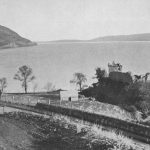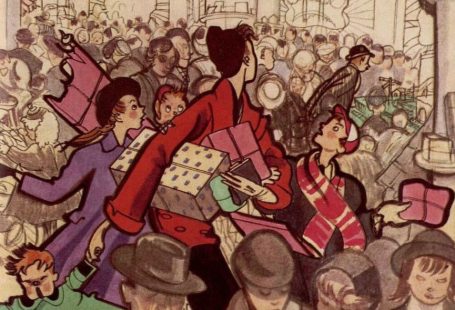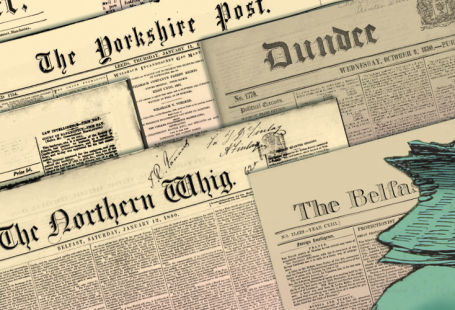In late 1937 in the borough of Croydon, South London, people began to fall ill with typhoid. Typhoid is a disease that is associated with contaminated water and outbreaks of the illness, at least in the United Kingdom, is something that we might associate today with the nineteenth century, before an age of improved sanitation and safe supplies of drinking water.

And so, in this special blog, we will take a look at how the Croydon typhoid epidemic gradually unfolded, as news of infections and subsequent deaths reached the press, in what many will recognise as a foreshadowing of the ongoing global pandemic, albeit in microcosm.
Register now and explore the Archive
5 November 1937 – First Reports
On 5 November 1937, the Surrey Mirror printed this brief paragraph:
Ten people have been affected by an outbreak of typhoid fever in the Croydon district. Eight of them have been taken to the Croydon Fever Hospital, and the condition of two is stated to be serious.

This was one of the earliest mentions of the outbreak of typhoid in Croydon, although the first case had been notified several days before, on 27 October 1937. Initially, officials were keen to keep the news of any typhoid infections out of the press, as they strove to understand their source. It seemed inconceivable that the infections could have originated from Croydon. At first it was thought that the cases of typhoid had stemmed from mainland Europe, from contaminated shellfish which had been imported into Britain.
Local officials, however, soon discovered the source of the outbreak, and it was very close to home. The cases of typhoid had stemmed from an infected well in the borough, the Addington well, which supplied between one fifth and one sixth of Croydon’s population, which sat at about 250,000 in total, with water. And although the well was closed on 4 November 1937, the damage had already been done.
12 November 1937 – 3 Deaths – 34 Cases
A week after the Surrey Mirror reported on the first cases of typhoid in Croydon, news of the epidemic had begun to reach the national press. On the 12 November 1937 the Daily Mirror reported that:
Three deaths have occurred in the Croydon, Surrey, typhoid epidemic – one at Croydon Isolation Hospital, another at a London fever hospital, and the third at the patient’s home – it was announced yesterday. Thirty-four cases have been notified.

Even though, as the Yorkshire Post and Leeds Intelligencer reported on the same day, the ‘infected well at Addington’ had been identified, more cases of typhoid could be expected, due to the nature of the disease:
More may be expected until the long incubation of typhoid has lapsed from the date of stopping the contaminated water supply.

Typhoid, due to its ‘long incubation period,’ could take weeks to develop. And although the infected well had been closed, people were still at risk of developing the disease if they had consumed the contaminated water, even if they were not currently exhibiting any symptoms.
But local officials were quick to assure the public that Croydon’s water supply was now safe. The Daily Mirror on 12 November 1937 reported how the Croydon Medical Officer of Health had advised the public that due to ‘additional measures taken for the treatment of Croydon water by chlorination and the cutting off of the contaminated supply’ they did not need to boil their water:
‘In view of this heavy chlorination,’ he explained, ‘boiling is not really necessary, but it will help to drive off any excess chlorine and so improve the taste. Samples of water are being taken from all houses in which cases have occurred to ascertain that the chlorination measures are effective.’
In spite of these assurances, the fear that Croydon families must have felt is unimaginable, that at any moment, they might fall ill with a potentially fatal disease.
13 November 1937 – The ‘Latest Official Statement’
On 13 November 1937, one of Croydon’s local papers, the Croydon Times, printed the ‘latest official statement’ from Town Clerk Mr. E. Taberner. Mr. Taberner again reassured the public that everything was being done to make the borough’s water supply safe, and that the water was no longer contaminated with the bacteria that caused typhoid:
A report from an eminent firm of bacteriologists, specialising in water supply, who have been called in at the invitation of the Corporation, has just been received. It confirms that everything that can be done in the sterilisation of water going into the supply against all possible infection, has been done effectively and adequately, and that treatment by chlorination, which is being administered, is sufficient to ensure perfectly safe water free from infection.

He did, however, add this caveat:
People returning from holiday to houses that have been unoccupied for some time, where there are cold water storage tanks, might as a measure of greater security, first run off the stored water.
It was a small caveat, but the risk of further infections was an ever present one, the same article featuring this statement from Mrs. Bessie Roberts, Chairman of the Public Health Committee:
Unfortunately, typhoid fever is difficult to diagnose in its early stages and the time elapsing from the date of a probable infection to the date when diagnosis is sure may be as long as 14 days.

But again, Mrs. Roberts outlined how the water supply to the area had been ‘thoroughly treated,’ and there was ‘no need for householders to take any special steps with respect to it.’
15 November 1937 – 4 Deaths – 55 Cases
Just two days later on 15 November 1937 the Aberdeen Press and Journal detailed how ‘two fresh cases of typhoid were reported at Croydon during the week-end, making the known total fifty-five.’
Three people were ‘seriously ill,’ whilst four people had passed away.

The impact on Croydon as community was being acutely felt, the Aberdeen Press and Journal reporting how:
In several Croydon churches prayers were said for the sufferers and for the bereaved families.
Tragically, the numbers of those impacted by the epidemic would only rise in the coming weeks and months.
16 November 1937 – 5 Deaths – 70 Cases
The next day, on 16 November 1937, the Daily Mirror reported how ‘More than seventy cases have occurred in the typhoid epidemic.’ Five deaths had been reported, with forty-two people being ‘very ill indeed.’
One of those who was suffering badly from the effects of typhoid was Mrs. A.G. Esnor, who was the daughter of M.P. Harry Day. With his position in politics, he was set to ‘demand Government action from the Minister of Health.’

Meanwhile, M.P.s in different parts of the country had been stirred into action by the Croydon epidemic, the Daily Mirror relating how ‘Several other M.P.s also want to know about the water supply in other parts of the country.’ The cases in Croydon had awoken a national interest, and sparked fear as to how water supplies were managed across the United Kingdom.
But it was Croydon, and Croydon alone, that was home to the typhoid outbreak in November 1937. In a nod to the impact on the local community, lead thief John Donovan was granted a ‘week’s remand on bail,’ as there were ‘two funerals pending in his family.’ The Daily Mirror reported that this concession was given because Donovan’s father had recently passed away, and ‘another relation had died as a result of the Croydon typhoid epidemic.’
The community in Croydon demanded action, and on 18 November 1937 the Dundee Evening Telegraph reported how a ‘deputation from Croydon’ was made to Sir Kingsley Wood, the then Minister of Health, demanding a ‘Government inquiry into the outbreak of typhoid fever’ in their borough.

9 December 1937 – 17 Deaths – 263 Cases
By 9 December 1937, well over a month after the initial case was reported, seventeen people had lost their lives due to the Croydon typhoid epidemic, with 263 cases reported in all. Recent deaths had included ‘a woman from the Old Town,’ and the ‘ten-year-old son of Mrs. Rivers-Moore.’ Typhoid is known to have a particularly deadly impact on children, and the epidemic in Croydon was sad evidence of that.
However, the West Sussex Gazette was reporting on 9 December 1937 how:
Consistent decline in new typhoid cases at Croydon justifies the view that the end of the epidemic is well in sight. Over Sunday and the four preceding days they averaged less than four, and deaths in the same period were three.
This perceived decline, as reported the newspaper, was heralded by ‘the obvious return of confidence by the shopping public,’ who had started to go about their business as usual once more. But one thing had changed; a radio report linking watercress with the typhoid outbreak had ‘almost killed the trade’ of the ‘tea-table and salad item’ in the area, with large watercress beds lying just outside of Croydon, which were fed by the River Wandle, being seen as a locus of infection.

One farmer, as reported the West Sussex Gazette, saw his business decline by ‘over 80 per cent,’ and he had to lay off 40 employees due to the misinformed rumours. And it was fake news, for as far as officials were concerned, ‘water-cress has now been exonerated from all blame, so far as Croydon is concerned.’
But despite the declining rates of infection, and the suspicion that was directed against watercress, still the community in Croydon continued to suffer from the effects of the outbreak.
The West Sussex Gazette reported how in ‘adjacent districts notices had been put up that people should not enter infected areas to shop.’ These notices were not issued by officials, and there was no such advice in place. As a result, two Croydon M.P.s, Lieutenant-Colonel G.K.M. Mason and Mr. H.G. Williams issued a statement regarding the ‘unjustified fear of infection’ that had followed the epidemic, ‘whether relating to shopping or going to places of amusement.’

Indeed, Croydon’s reputation had suffered, and many believed the area had been unfairly stigmatised in the wake of the typhoid outbreak. Mason and Williams addressed this point, making a protest to ‘certain London dailies of the ‘smart’ kind against the extravagantly alarmist way in which they have dealt with the epidemic.’
Meanwhile, just as the watercress farmers suffered a blow to their trade, small-holders in the Addington area were also suffering from the fallout that followed the epidemic. The West Sussex Gazette detailed how the small-holders were:
…apparently to be asked to pay their share of the cost of the new drainage scheme by which about 30 cesspools are to be abolished – these in the vicinity of the well that was found to be contaminated.
One of the small-holders was then reported as saying:
As a community…we are bankrupt. We have only our holdings. Our only hope, after years of hard work and privation, is removal of the restriction of one house per plot, so that we may dispose of our holdings as building land.
The impact of the Croydon typhoid epidemic was being felt across the community, and the community demanded answers.
10 December 1937 – 18 Deaths – 271 Cases
The next day, on 10 December 1937, the Yorkshire Post and Leeds Intelligencer reported how ‘one more typhoid death was notified at Croydon yesterday,’ that off 63-year-old Minnie Smith of Selsdon Road. Meanwhile, two more cases were recorded. The epidemic was not over yet.

Meanwhile, the public enquiry, which had begun on 6 December, into the epidemic was soon adjourned. As the Illustrated London News reported, this was to allow the Corporation of Croydon ‘to prepare its case,’ its officials still being ‘fully occupied in dealing with the outbreak.’
The enquiry was to be conducted by Mr. H.L. Murphy K.C., with former physician to King George V Sir Humphrey Rolleston and past President of the Institution of Water Engineers Mr. H.J.F. Gourley acting as assessors. They toured the area, the first point of their visit being the Addington well.
The Illustrated London News, meanwhile, on 11 December 1937 printed some more ‘reassuring news’ for the inhabitants of Croydon. This statement was provided by Dr. E.V. Suckling, a bacteriologist:
I am satisfied that since November 11 the public water-supply of Croydon has been bacteriologically pure and wholesome, and suitable for drinking and domestic purposes.

Additional comments were given respectively by Lords Dawson and Horder at a Croydon Chamber of Commerce lunch, the former stating that the ‘disease is not spread by people circulating in shops and thoroughfares,’ and the latter condemning the ‘unjustified scare’ that was ‘affecting the businesses of Croydon.’
As the enquiry reconvened, the Hull Daily Mail on 23 December 1937 reported how ‘all parties agreed that the infection was water-borne and came from the Addington Well source.’ Meanwhile, as the enquiry continued, another sad death from typhoid was reported, that of a schoolboy.
The enquiry looked at how work was being undertaken at the Addington well ‘in late September and October.’ It was thought that this work, coupled with a failure to chlorinate the water, and the employment of a man who was carrying typhoid, had led to the deadly outbreak.

Representing the Typhoid Outbreak Committee, Mr. A.M. Lyons turned on Dr O.M. Holden, the Medical Officer of Health for Croydon, during the enquiry proceedings. Lyons wanted to hold Holden accountable for the epidemic, although lawyer Sir Walter Monckton (an advisor to King Edward VIII during the abdication crisis) stated there were no such regulations that held Holden responsible ‘in regards to water supply.’
But this did not stop Lyons, who demanded of Dr Holden:
Did you ever taste the water after 1936? Did you ever see the water? Did you ever see the analyses after 1936? I put it to you that if you looked at any of these things you would have known that this was not being done and had not been done?
The community still desperately wanted answers, if not somebody to blame.
11 January 1938 – 39 Deaths
As Croydon entered the new year, still more deaths and cases were being recorded. As the Londonderry Sentinel reports on 11 January 1938, the last death had been notified on the first of the month, whilst secondary cases had emerged ‘among nurses who have been attending patients,’ one at Warlingham Park Mental Hospital, and the other at Croydon’s Mayday Hospital.

Meanwhile, Croydon Corporation employee Mr. Dingle Foot refuted claims that the carelessness of the workers who had worked on the well was to blame for the epidemic. He stated that ‘every possible care was taken,’ and that ‘there was not one single shred of evidence that one man disobeyed instruction.’
And after sitting seventeen times, the enquiry into the Croydon typhoid outbreak finally came to an end, as reported the Hull Daily Mail on 12 January 1938.

Here, Sir Walter Monckton once again defended the actions of Medical Officer Doctor Holden, remarking that it ‘could not possibly be suggested that Doctor Holden…was guilty of slowness in looking at the water supply.’ Indeed, he lauded officials for discovering the cause of the epidemic ‘very quickly,’ as ‘from a scientific point of view the diagnosis was quickly made.’
A report on the enquiry and its finding was to be published ‘as soon as possible.’ The contamination of the Addington well was to be blamed, with the three factors of the work that was done on the well, the employment of the worker who was infected with typhoid, and the failure to chlorinate the water, resulting in the contamination of the well.
20 January 1938 – 40 Deaths – 295 Cases
And although the enquiry had finished, the Croydon borough continued to be impacted by the disease, as the deaths had not yet stopped. On 20 January 1938 the Dundee Evening Telegraph reported on the death that day of a 15-year-old boy, although no other new cases had been notified. The total cases sat at 295.

By the end of the month, however, the same newspaper was reporting how ‘The outbreak is rapidly dying out.’ No primary cases had occurred since 25 December 1937, whilst the number of deaths was now 43.
An official statement ran as follows:
The outbreak is rapidly dying out…if, indeed, one may not say that it has already ceased. There is not the slightest reason for the citizens of Croydon to fear that there has been any recrudescence of the outbreak.
After this, there would be no more deaths, but the total of reported cases numbered 341. The Croydon typhoid epidemic would have a lasting impact on the town, on both its inhabitants and its reputation. And the fear and the false news that was spread by the press in 1937 and 1938 is all to similar to the frenzy of panic that accompanied the global pandemic over 80 years later, in 2020. It is something we can very much recognise today, although we scarcely thought we would have to live through such a period, much like the citizens of Croydon must have felt, as friends and neighbours succumbed to the disease.
What historical parallels to today can you find on The Archive? Begin your search with us here today, and don’t forget to let us know what you discover.






